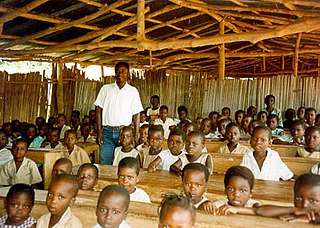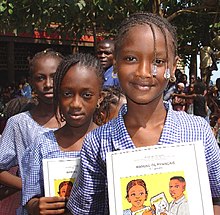Education in Colombia includes nursery school, elementary school, high school, technical instruction and university education.

Education in Costa Rica is divided in 3 cycles: pre-education, primary education, and secondary school, which leads to higher education. School year starts between the second and third week of February, stops at the last week of June, it continues again between the third and fourth week of July and finishes between the last week of November and the second week of December. Preschool and basic education are free to the public. Elementary and secondary school are both divided in two cycles. Since 1869, education is free and compulsory.
Education in Belarus is free at all levels except for higher education. The government ministry that oversees the running of the school systems is the Ministry of Education of the Republic of Belarus. Each of the regions inside Belarus has oversight of the education system, and students may attend either a public (state) or a private school. The current structure of the educational system was established by decree in 1994. The education system is also based on The Education Code of the Republic of Belarus and other educational standards.

Practically all children attend Quranic school for two or three years, starting around age five; there they learn the rudiments of the Islamic faith and some classical Arabic. When rural children attend these schools, they sometimes move away from home and help the teacher work his land.
Education in Kyrgyzstan is compulsory for nine years, between ages seven and 15. Following four years of primary and five years of lower secondary school, the system offers two years of upper secondary school, specialized secondary school, or vocational/technical school.
During Alfredo Stroessner Mattiauda’s presidency (1954–89), education initiatives took a backseat to economic concerns and the task of controlling political adversaries, and teacher salaries fell to extremely low levels. The constitution of 1992 attempted to remedy the long neglect of education. Article 85 of the constitution mandates that 20% of the government budget be designated for educational expenditures. This measure, however, has proven to be impractical and has been largely ignored.

Education in Dominica is compulsory from ages 5 to 16. The gross primary enrollment rate was 100.4 percent in 1991 and 98.2 percent in 1998, and the net primary enrollment rate was 88.7 percent in 1991 and 88.8 percent in 1998. Primary school attendance rates were unavailable for Dominica as of 2001. Poor physical conditions in many primary schools affect the quality of education, while some schools are overcrowded, limiting access to primary education, particularly for children living in urban areas around the capital. Poverty and work on family banana farms during the harvest season can affect school attendance, but other employment does not pull minors out of school. There is a significant Carib Indian population in Dominica, and schools on the Carib Territory are reported to have fewer resources.
Education in Grenada is free and compulsory between the ages of 6 and 14 years. In 1998, the gross primary enrollment rate was 125.5 percent, while the net primary enrollment rate was 97.5 percent. Despite the high enrollment rate, poverty, poor school facilities, and the periodic need to help with family farm harvests have resulted in approximately a 7 percent absenteeism rate among primary school children.

Education in Honduras is essential to the country of Honduras, for the maintenance, cultivation, and spread of culture and its benefits in Honduran society without discriminating against any particular group. The national education is secular and founded on the essential principles of democracy, inculcating and fomenting strong nationalist sentiments in the students and tying them directly to the economic and social development of the nation. Honduras's 1982 Constitution guarantees the right to education, a right also conveyed through the National Constituent Assembly's Decree 131 and in the official daily publication La Gaceta.

Education in St. Lucia is primarily based on the British education system and is provided in public and private schools.
Education in Saint Vincent and the Grenadines is neither compulsory nor free, although children are usually in school until the age of 15. In 1998, the gross primary enrollment rate was 90.5 percent, and the net primary enrollment rate was 83.5 percent.
Education in Georgia is free of charge and compulsory from the age of 6 until 17-18 years. In 1996, the gross primary enrollment rate was 88.2 percent, and the net primary enrollment rate was 87 percent; 48.8 percent are girls and 51.8 percent are boys. Constitution mandates that education is free. Related expenses that include textbooks and laptops are provided by the state free of charge; in 2001 there were 47,837 children not attending primary school.

Benin has abolished school fees and is carrying out the recommendations of its 2007 Educational Forum. In 2018, the net primary enrollment rate was 97 percent. Gross enrollment rate in secondary education has greatly increased in the last two decades, from 21.8 percent in 2000 to 59 percent in 2016, 67.1 percent in the case of males and 50.7 percent for females. Because of a rapid increase in the enrollment rate, the student/teacher ratio rose from 36:1 in 1990 to 53:1 in 1997 but has dropped again in the last years to 39:1 (2018). In 2018, the gross enrollment ratio in tertiary education was 12.5%.

Public education in the Central African Republic is free, and education is compulsory from ages 6 to 14. AIDS-related deaths have taken a heavy toll on teachers, contributing to the closure of more than 100 primary schools between 1996 and 1998.
Primary school education in Fiji is compulsory, and subsidised for eight years. In 1998, the gross primary enrollment ratio was 110.5 percent, and the net primary enrollment rate was 99.4 percent. As of 2001, attendance was decreasing due to security concerns and the burden of school fees, often due to the cost of transport. In 2013, the Bainimarama government made education at the primary and secondary level in Fiji free for all students. Fiji has since achieved universal access to primary education.
.
Education in Kiribati is free and compulsory from age 6 to 14, which includes primary school through grade six, and Junior Secondary School for three additional grade levels. In 1998, the gross primary enrollment rate was 84.4 percent, and net primary enrollment rate was 70.7 percent. School quality and access to education are better in urban areas; schools in small communities on isolated islands are expensive to maintain. Mission schools are slowly being absorbed into the government primary school system.
Education in Tonga is compulsory for children through the end of high school. In 1995, the gross primary enrolment rate was 122.2 percent, and the net primary enrolment rate was 95.3 percent. Primary school attendance rates were unavailable for Tonga as of 2001. While enrolment rates indicate a level of commitment to education, they do not always reflect children's participation in school. 98.5% of students in Tonga attend schools while the other 2% are either living in remote areas without certain schools, such as in the Niua group, or they do not have enough funds to pay for their enrolment. There are about twenty institutions for higher education, 22 high schools, and around 95 primary schools including pre-schools in different villages around Tonga.
The Human Rights Measurement Initiative finds that Equatorial Guinea is fulfilling 43.5% of what it should be fulfilling for the right to health based on its level of income. When looking at the right to health with respect to children, Equatorial Guinea achieves 64.4% of what is expected based on its current income. In regards to the right to health amongst the adult population, the country achieves only 58.8% of what is expected based on the nation's level of income. Equatorial Guinea falls into the "very bad" category when evaluating the right to reproductive health because the nation is fulfilling only 7.3% of what the nation is expected to achieve based on the resources (income) it has available.

Life expectancy at birth in Belarus was 69 for men and 79 for women in 2016.
The Human Rights Measurement Initiative finds that Suriname is fulfilling 78.4% of what it should be fulfilling for the right to health based on its level of income. When looking at the right to health with respect to children, Suriname achieves 94.0% of what is expected based on its current income. In regards to the right to health amongst the adult population, the country achieves only 83.2% of what is expected based on the nation's level of income. Suriname falls into the "very bad" category when evaluating the right to reproductive health because the nation is fulfilling only 57.9% of what the nation is expected to achieve based on the resources (income) it has available.








